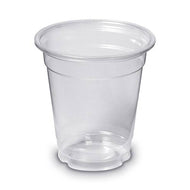In our fast-paced world, disposable cups have become essential items for both businesses and consumers. These convenient containers come in various materials, each with unique properties suited for different applications. From plastic options that prioritize durability to paper alternatives emphasizing eco-friendliness, understanding the distinctions between disposable cup types helps users make informed choices based on their specific needs. This guide explores the main categories of disposable cups—plastic, paper, and foam—highlighting their characteristics, advantages, and ideal applications.
Plastic Cups
Plastic disposable cups represent the most accessible and affordable option in the disposable drinkware market. Their popularity stems from extensive research and development that has continually improved their design and functionality. While plastics have historically raised environmental concerns, ongoing research focuses on creating more eco-friendly alternatives that maintain convenience while reducing environmental impact. These research efforts have yielded promising results, with several environmentally responsible plastic cup options now readily available.
Types of Plastic Cups
Versalite Cups
Versalite cups represent the latest innovation in recyclable drinkware. These fully recyclable cups are manufactured with polypropylene designed specifically for environmental compatibility. Their durability makes them highly resistant to punctures and cracks—an important safety feature since damaged plastics can potentially leach chemicals into beverages. This resilience also makes them particularly suitable for children, eliminating health concerns during both drinking and play activities.
Compostable Cups
These innovative products represent the truly eco-friendly segment of plastic cups. Manufactured using polylactic acid (PLA), a plant-derived polymer sourced from corn, potato, or soy, these cups offer a more sustainable alternative to traditional plastics. This pseudo-plastic material provides excellent food safety, freezer compatibility, and affordability. However, as a relatively new material, proper recycling requires specialized facilities that may not be universally available through all recycling programs.
Key Point: Compostable plastic cups made from PLA offer environmental benefits but require specialized recycling facilities. Check with local waste management services to ensure proper disposal.
Hard Layer Cups
Hard layer cups utilize a multi-layered construction that creates a robust, shock-absorbing material. This design makes them exceptionally well-suited for active lifestyles, catering services, and children's use. Their durability creates an excellent balance between reusability and sustainability, reducing their environmental impact compared to single-use alternatives. This plastic type is commonly used in tumblers, baby cups, and protein shakers where durability is essential.
Thin Wall Cups

Durable hard layer cups provide excellent stability and shock resistance
Thin wall plastic cups represent the iconic, universally recognized disposable cup found at parties, offices, and homes worldwide. Available in various materials to accommodate diverse applications, these cups demonstrate the extensive research invested in plastic cup technology. Some variations prioritize superior freezing resistance, while others emphasize shock absorption properties. Despite this versatility, it's crucial to note that all single-wall plastics should never contact hot liquids, as high temperatures can compromise both user safety and recycling potential.
Quick Tip: Never use thin wall plastic cups with hot beverages. High temperatures can cause the plastic to leach chemicals and significantly reduce recyclability.
Paper Cups
Paper cups rank second in popularity among disposable drinkware options. While slightly more expensive than their plastic counterparts, they offer easier recyclability and superior temperature resistance. These cups primarily consist of biodegradable materials, eliminating concerns about toxicity. However, their susceptibility to tearing creates a significant disadvantage compared to plastic alternatives, potentially resulting in more frequent replacement and waste.
Types of Paper Cups
Insulated Cups
While paper cups generally offer better temperature handling than plastic, standard versions still conduct heat, making them potentially unsafe for hot beverages. Insulated cups solve this problem through innovative design featuring two paper sheets with an air pocket between layers. This air pocket creates effective thermal insulation, preventing heat transfer to the outer surface and enabling comfortable handling of hot drinks without burning risks.
Poly-coated Paper Cups
Poly-coated paper cups incorporate a polymer coating that enhances safety and functionality. These polymers—organic materials known for their strength and rigidity—typically derive from tree sources and resemble wax in appearance. Unlike traditional wax, however, these polymers remain non-toxic when contacting liquids and resist condensation "sweating," creating a longer-lasting cup with superior performance.
Recycled Paper Cups
These environmentally conscious options utilize recycled materials including paper, cardboard, and wood fragments. While the resulting material may have a coarser texture than virgin alternatives, combining various recycled components addresses the challenge of material degradation during recycling processes. This approach maximizes resource efficiency while providing functional disposable cups for various applications.
Wax Coated Paper Cups
Commonly found in movie theaters, fast-food establishments, and recreational venues, wax-coated cups typically serve cold beverages like sodas, milkshakes, and iced tea. These cups deliberately avoid hot drink applications that could melt the protective wax layer. Their popularity stems partly from economic considerations—wax provides a more affordable alternative to polymer coatings, making these cups particularly attractive for high-volume purchasing and budget-conscious applications.
Foam Cups
Foam cups offer exceptional versatility despite their higher price point compared to other disposable options. They effectively handle both hot and cold beverages, though they remain more susceptible to damage than plastic while offering better tear resistance than paper alternatives. Manufactured from polystyrene—derived from petroleum byproducts—these cups can present health risks if used beyond their temperature limitations, making it essential for users to verify temperature specifications before use.
Disposable Cups: Meeting Modern Lifestyle Needs
Convenience plays a crucial role in contemporary life, helping preserve time, mental well-being, and stress management. Disposable cups address these needs perfectly through their lightweight design, portability, and minimal financial impact if lost or damaged. Their popularity extends to business applications, where they provide cost-effective solutions that enhance customer experience without adding unnecessary complications.
Each disposable cup type offers distinct advantages for specific applications. Plastic options balance affordability with versatility, paper alternatives emphasize environmental considerations, and foam cups provide superior temperature versatility. Understanding these differences helps consumers and businesses select the most appropriate option for their unique requirements.
Explore Our Disposable Cup Solutions
Find the perfect disposable cups for your business or personal needs with our extensive selection.

 Violet Zhang
Violet Zhang

















































